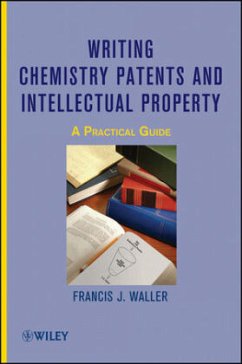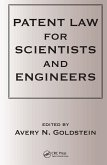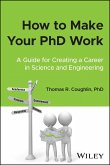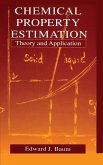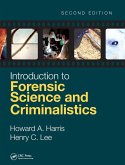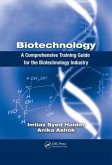- Gebundenes Buch
- Merkliste
- Auf die Merkliste
- Bewerten Bewerten
- Teilen
- Produkt teilen
- Produkterinnerung
- Produkterinnerung
Understanding intellectual property, safeguarding your ideas
Intellectual property is constantly at risk, and the protection of chemical science and technology through the patenting process allows individuals and companies to protect their hard work. But in order to truly be able to protect your ideas, you need to understand the basics of patenting for yourself.
A practical handbook designed to empower inventors like you to write your own patent application drafts in conjunction with an attorney, Writing Chemistry Patents and Intellectual Property: A Practical Guide presents a brand new…mehr
Andere Kunden interessierten sich auch für
![Patent Laws for Scientists and Engineers Patent Laws for Scientists and Engineers]() Avery N. Goldstein, Gifford, Krass, Groh, Sprinkle, Anderson / P.C. Citkowski (eds.)Patent Laws for Scientists and Engineers174,99 €
Avery N. Goldstein, Gifford, Krass, Groh, Sprinkle, Anderson / P.C. Citkowski (eds.)Patent Laws for Scientists and Engineers174,99 €![Forensic Law Casebook Forensic Law Casebook]() Charles P NemethForensic Law Casebook107,99 €
Charles P NemethForensic Law Casebook107,99 €![How to Make Your PhD Work How to Make Your PhD Work]() Thomas R. CoughlinHow to Make Your PhD Work20,99 €
Thomas R. CoughlinHow to Make Your PhD Work20,99 €![Chemical Property Estimation Chemical Property Estimation]() Edward BaumChemical Property Estimation77,99 €
Edward BaumChemical Property Estimation77,99 €![Mastering Academic Writing in the Sciences Mastering Academic Writing in the Sciences]() Marialuisa AliottaMastering Academic Writing in the Sciences174,99 €
Marialuisa AliottaMastering Academic Writing in the Sciences174,99 €![Introduction to Forensic Science and Criminalistics, Second Edition Introduction to Forensic Science and Criminalistics, Second Edition]() Howard A HarrisIntroduction to Forensic Science and Criminalistics, Second Edition154,99 €
Howard A HarrisIntroduction to Forensic Science and Criminalistics, Second Edition154,99 €![Workplace Drug Testing Workplace Drug Testing]() Steven B. Karch (ed.)Workplace Drug Testing197,99 €
Steven B. Karch (ed.)Workplace Drug Testing197,99 €-
-
-
Understanding intellectual property, safeguarding your ideas
Intellectual property is constantly at risk, and the protection of chemical science and technology through the patenting process allows individuals and companies to protect their hard work. But in order to truly be able to protect your ideas, you need to understand the basics of patenting for yourself.
A practical handbook designed to empower inventors like you to write your own patent application drafts in conjunction with an attorney, Writing Chemistry Patents and Intellectual Property: A Practical Guide presents a brand new methodology for success.
Based on a short course author Francis J. Waller gives for the American Chemical Society, the book teaches you how to structure a literature search, to educate the patent examiner on your work, to prepare an application that can be easily duplicated, and to understand what goes on behind the scenes during the patent examiner's rejection process.
Providing essential insights, invaluable strategies, and applicable, real-world examples designed to maximize the chances that a patent will be accepted by the United States Patent and Trademark Office, Writing Chemistry Patents and Intellectual Property is the book you need if you want to keep your work protected.
Hinweis: Dieser Artikel kann nur an eine deutsche Lieferadresse ausgeliefert werden.
Intellectual property is constantly at risk, and the protection of chemical science and technology through the patenting process allows individuals and companies to protect their hard work. But in order to truly be able to protect your ideas, you need to understand the basics of patenting for yourself.
A practical handbook designed to empower inventors like you to write your own patent application drafts in conjunction with an attorney, Writing Chemistry Patents and Intellectual Property: A Practical Guide presents a brand new methodology for success.
Based on a short course author Francis J. Waller gives for the American Chemical Society, the book teaches you how to structure a literature search, to educate the patent examiner on your work, to prepare an application that can be easily duplicated, and to understand what goes on behind the scenes during the patent examiner's rejection process.
Providing essential insights, invaluable strategies, and applicable, real-world examples designed to maximize the chances that a patent will be accepted by the United States Patent and Trademark Office, Writing Chemistry Patents and Intellectual Property is the book you need if you want to keep your work protected.
Hinweis: Dieser Artikel kann nur an eine deutsche Lieferadresse ausgeliefert werden.
Produktdetails
- Produktdetails
- Verlag: Wiley & Sons
- Artikelnr. des Verlages: 14549740000
- 1. Auflage
- Seitenzahl: 256
- Erscheinungstermin: 21. September 2011
- Englisch
- Abmessung: 242mm x 161mm x 19mm
- Gewicht: 515g
- ISBN-13: 9780470497401
- ISBN-10: 0470497408
- Artikelnr.: 33255876
- Herstellerkennzeichnung
- Libri GmbH
- Europaallee 1
- 36244 Bad Hersfeld
- gpsr@libri.de
- Verlag: Wiley & Sons
- Artikelnr. des Verlages: 14549740000
- 1. Auflage
- Seitenzahl: 256
- Erscheinungstermin: 21. September 2011
- Englisch
- Abmessung: 242mm x 161mm x 19mm
- Gewicht: 515g
- ISBN-13: 9780470497401
- ISBN-10: 0470497408
- Artikelnr.: 33255876
- Herstellerkennzeichnung
- Libri GmbH
- Europaallee 1
- 36244 Bad Hersfeld
- gpsr@libri.de
FRANCIS J. WALLER, PhD, is a former senior research associate with Air Products and Chemicals, Inc. with more than thirty-five years of experience in industry and teaching. Dr. Waller is the author or coauthor of forty-six U.S. patents and received the Paul Rylander Award from the Organic Reactions Catalysis Society in 2001.
PREFACE xiv
ACKNOWLEDGMENTS xvii
1. BACKGROUND AND HISTORICAL PERSPECTIVE ABOUT INTELLECTUAL PROPERTY 1
Chapter Objective 1
Introduction 1
Book Strategy for Patents 6
A Brief History of Patenting 7
Intellectual Property: Is It Important or Not? 8
The U.S. Patent and Trademark Office 9
Why Intellectual Property Protection Is Currently Important 13
Information Overload and Prior Art 15
China as an Emerging Intellectual Powerhouse 18
Patents as Sources of Technology 19
Patents in Force Worldwide 20
Chapter Summary 20
Additional Reading 20
Question 21
2. BRIEF INTRODUCTION TO VOCABULARY AND DEFINITIONS 22
Chapter Objective 22
Introduction 22
Short Story from Panama 23
Patent Terminology 24
Trade Secret Definition 30
Copyright 31
Trademark Definition 32
Chapter Summary 33
Additional Reading 33
Questions 34
3. YOUR FIRST DECISION: TRADE SECRET OR PATENT? 35
Chapter Objective 35
Introduction 35
Trade Secret 36
Patent 39
Comparison between a Trade Secret and a Patent 40
Chapter Summary 41
Additional Reading 41
Question 42
4. WHAT COMES FIRST: A PROVISIONAL OR NONPROVISIONAL PATENT APPLICATION? 43
Chapter Objective 43
Introduction 43
Provisional Patent Application 45
Nonprovisional Patent Application 48
Patent Application Comparison 49
Chapter Summary 50
Additional Reading 50
Question 50
5. REASONS FOR PATENT OFFICE REJECTIONS 51
Chapter Objective 51
Introduction 51
Patentable Invention and Its Usefulness 52
Novelty 53
Nonobviousness 54
Other Reasons for a Rejection 56
Chapter Summary 57
Additional Reading 57
Question 58
6. REASONS FOR INVALID PATENTS 59
Chapter Objective 59
Introduction 59
Experiments: Actual or by Insight 60
Prior Art Disclosure 60
Issued Patent Is Invalid 61
Inequitable Conduct 62
Other Considerations When Writing Your First Patent Application 62
Another Point of View 63
Chapter Summary 63
Additional Reading 64
Question 64
7. EXAMPLES OF PATENT SPECIFICATIONS 65
Chapter Objective 65
Introduction 65
Key to Patenting Success 66
Why Understanding Patents Is Important 66
Typical Pathway for Patent Application within a Company 67
Claim 1 and 2 of U.S. Patent 5,247,190 68
Examination of U.S. Patent 5,872,289 71
Format for Patent with Federal Support 76
Examination of U.S. Patent 6,369,239 77
Examination of U.S. 20040010115A1 79
Examination of U.S. Patent 7,071,289 81
Examination of U.S. Patent 5,273,995 82
Examination of U.S. Patent 7,253,209 83
Comparing Claim Language with Written Description of Invention 85
Chapter Summary 87
Additional Reading 88
Questions 88
8. WRITING THE PATENT APPLICATION 89
Chapter Objective 89
Introduction 89
The Inventive Process 90
Summary of Our Understanding for Patents and Trade Secrets 92
Identifying a Problem to Be Solved 93
Methodology to Solve a Complex Problem 97
Possible Inventions from Our Everyday Reading 101
Patentability Requirements 102
Circumventing the Rules of Electrophilic Aromatic Substitution 103
Water Splitting via Ruthenium Complex 105
Detecting Mechanical Stress within a Polymer 108
Places to Find Future Problems 110
Controlling Molecular Size of Semiconductor Quantum Dots 111
Chapter Summary 113
Additional Reading 113
Question 114
9. AN EXAMINATION OF CLAIM FORMAT 115
Chapter Objective 115
Introduction 115
Interpretation of Claims 116
General Background about Claim Language 118
More Definition about Claims 119
Specific Claim Language 120
Chapter Summary 123
10. WHY YOU NEED CONFIDENTIALITY AGREEMENTS 124
Chapter Objective 124
Introduction 124
Confidentiality Agreements in General 125
Important Elements within a Confidentiality Agreement 125
Chapter Summary 127
Question 127
11. PRACTICAL INFORMATION ABOUT COPYRIGHTS AND TRADEMARKS 128
Chapter Objective 128
Introduction 128
Copyright 129
Copyright Interpretation 131
Adjunct Professor Appointments and the Copyright 133
Filing for a Copyright 136
Trademarks 137
Chapter Summary 139
Question 140
12. GLOBAL PATENT FILING AND PATENTING STRATEGY 141
Chapter Objective 141
Introduction 141
Developing a Patent Strategy 142
International Patent Filing 143
Filing Options 145
Chapter Summary 146
Questions 147
13. WHAT ACADEMIC SCIENCE FACULTY SHOULD KNOW ABOUT PATENTS AND COPYRIGHTS
148
Chapter Objective 148
Introduction 148
Recent Background 149
What Should You Do after Having a Novel Concept? 150
Notebooks 151
Invention Disclosure 152
Confidentiality Agreements 153
Copyrights 153
Chapter Summary 154
Additional Reading 154
Questions 154
14. INTELLECTUAL PROPERTY RESOURCES 155
Chapter Objective 155
Introduction 155
Brief Summary of Selected Intellectual Property Books 156
Intellectual Property Courses 162
Worldwide Patent Offices 163
Emerging Technology Fields 163
Useful Organization 164
Chapter Summary 165
Additional Reading 165
15. BOOK SUMMARY AND ON YOUR OWN 166
Chapter Objective 166
Introduction 166
Pending Intellectual Property Developments 167
Summary of Previous Chapters 167
Responsibilities of the Inventor 168
Conclusions 169
Chapter Summary 170
Additional Reading 170
16. RESPONSES TO QUESTIONS AT END OF CHAPTERS 171
Chapter Objective 171
Chapter 1 171
Chapter 2 172
Chapter 3 173
Chapter 4 173
Chapter 5 174
Chapter 6 176
Chapter 7 177
Chapter 8 178
Chapter 10 178
Chapter 11 179
Chapter 12 179
Chapter 13 180
17. PATENT APPENDIX 181
Chapter Objective 181
Useful Information Besides the Invention 181
Chapter Summary 184
U.S. Patent 5,872,289 185
U.S. Patent 6,369,239 194
U.S. Published Patent Application 20040010115A1 198
U.S. Patent 7,071,289 with Certificate of Correction 207
U.S. Patent 5,273,995 219
U.S. Patent 7,253,209 229
INDEX 236
ACKNOWLEDGMENTS xvii
1. BACKGROUND AND HISTORICAL PERSPECTIVE ABOUT INTELLECTUAL PROPERTY 1
Chapter Objective 1
Introduction 1
Book Strategy for Patents 6
A Brief History of Patenting 7
Intellectual Property: Is It Important or Not? 8
The U.S. Patent and Trademark Office 9
Why Intellectual Property Protection Is Currently Important 13
Information Overload and Prior Art 15
China as an Emerging Intellectual Powerhouse 18
Patents as Sources of Technology 19
Patents in Force Worldwide 20
Chapter Summary 20
Additional Reading 20
Question 21
2. BRIEF INTRODUCTION TO VOCABULARY AND DEFINITIONS 22
Chapter Objective 22
Introduction 22
Short Story from Panama 23
Patent Terminology 24
Trade Secret Definition 30
Copyright 31
Trademark Definition 32
Chapter Summary 33
Additional Reading 33
Questions 34
3. YOUR FIRST DECISION: TRADE SECRET OR PATENT? 35
Chapter Objective 35
Introduction 35
Trade Secret 36
Patent 39
Comparison between a Trade Secret and a Patent 40
Chapter Summary 41
Additional Reading 41
Question 42
4. WHAT COMES FIRST: A PROVISIONAL OR NONPROVISIONAL PATENT APPLICATION? 43
Chapter Objective 43
Introduction 43
Provisional Patent Application 45
Nonprovisional Patent Application 48
Patent Application Comparison 49
Chapter Summary 50
Additional Reading 50
Question 50
5. REASONS FOR PATENT OFFICE REJECTIONS 51
Chapter Objective 51
Introduction 51
Patentable Invention and Its Usefulness 52
Novelty 53
Nonobviousness 54
Other Reasons for a Rejection 56
Chapter Summary 57
Additional Reading 57
Question 58
6. REASONS FOR INVALID PATENTS 59
Chapter Objective 59
Introduction 59
Experiments: Actual or by Insight 60
Prior Art Disclosure 60
Issued Patent Is Invalid 61
Inequitable Conduct 62
Other Considerations When Writing Your First Patent Application 62
Another Point of View 63
Chapter Summary 63
Additional Reading 64
Question 64
7. EXAMPLES OF PATENT SPECIFICATIONS 65
Chapter Objective 65
Introduction 65
Key to Patenting Success 66
Why Understanding Patents Is Important 66
Typical Pathway for Patent Application within a Company 67
Claim 1 and 2 of U.S. Patent 5,247,190 68
Examination of U.S. Patent 5,872,289 71
Format for Patent with Federal Support 76
Examination of U.S. Patent 6,369,239 77
Examination of U.S. 20040010115A1 79
Examination of U.S. Patent 7,071,289 81
Examination of U.S. Patent 5,273,995 82
Examination of U.S. Patent 7,253,209 83
Comparing Claim Language with Written Description of Invention 85
Chapter Summary 87
Additional Reading 88
Questions 88
8. WRITING THE PATENT APPLICATION 89
Chapter Objective 89
Introduction 89
The Inventive Process 90
Summary of Our Understanding for Patents and Trade Secrets 92
Identifying a Problem to Be Solved 93
Methodology to Solve a Complex Problem 97
Possible Inventions from Our Everyday Reading 101
Patentability Requirements 102
Circumventing the Rules of Electrophilic Aromatic Substitution 103
Water Splitting via Ruthenium Complex 105
Detecting Mechanical Stress within a Polymer 108
Places to Find Future Problems 110
Controlling Molecular Size of Semiconductor Quantum Dots 111
Chapter Summary 113
Additional Reading 113
Question 114
9. AN EXAMINATION OF CLAIM FORMAT 115
Chapter Objective 115
Introduction 115
Interpretation of Claims 116
General Background about Claim Language 118
More Definition about Claims 119
Specific Claim Language 120
Chapter Summary 123
10. WHY YOU NEED CONFIDENTIALITY AGREEMENTS 124
Chapter Objective 124
Introduction 124
Confidentiality Agreements in General 125
Important Elements within a Confidentiality Agreement 125
Chapter Summary 127
Question 127
11. PRACTICAL INFORMATION ABOUT COPYRIGHTS AND TRADEMARKS 128
Chapter Objective 128
Introduction 128
Copyright 129
Copyright Interpretation 131
Adjunct Professor Appointments and the Copyright 133
Filing for a Copyright 136
Trademarks 137
Chapter Summary 139
Question 140
12. GLOBAL PATENT FILING AND PATENTING STRATEGY 141
Chapter Objective 141
Introduction 141
Developing a Patent Strategy 142
International Patent Filing 143
Filing Options 145
Chapter Summary 146
Questions 147
13. WHAT ACADEMIC SCIENCE FACULTY SHOULD KNOW ABOUT PATENTS AND COPYRIGHTS
148
Chapter Objective 148
Introduction 148
Recent Background 149
What Should You Do after Having a Novel Concept? 150
Notebooks 151
Invention Disclosure 152
Confidentiality Agreements 153
Copyrights 153
Chapter Summary 154
Additional Reading 154
Questions 154
14. INTELLECTUAL PROPERTY RESOURCES 155
Chapter Objective 155
Introduction 155
Brief Summary of Selected Intellectual Property Books 156
Intellectual Property Courses 162
Worldwide Patent Offices 163
Emerging Technology Fields 163
Useful Organization 164
Chapter Summary 165
Additional Reading 165
15. BOOK SUMMARY AND ON YOUR OWN 166
Chapter Objective 166
Introduction 166
Pending Intellectual Property Developments 167
Summary of Previous Chapters 167
Responsibilities of the Inventor 168
Conclusions 169
Chapter Summary 170
Additional Reading 170
16. RESPONSES TO QUESTIONS AT END OF CHAPTERS 171
Chapter Objective 171
Chapter 1 171
Chapter 2 172
Chapter 3 173
Chapter 4 173
Chapter 5 174
Chapter 6 176
Chapter 7 177
Chapter 8 178
Chapter 10 178
Chapter 11 179
Chapter 12 179
Chapter 13 180
17. PATENT APPENDIX 181
Chapter Objective 181
Useful Information Besides the Invention 181
Chapter Summary 184
U.S. Patent 5,872,289 185
U.S. Patent 6,369,239 194
U.S. Published Patent Application 20040010115A1 198
U.S. Patent 7,071,289 with Certificate of Correction 207
U.S. Patent 5,273,995 219
U.S. Patent 7,253,209 229
INDEX 236
PREFACE xiv
ACKNOWLEDGMENTS xvii
1. BACKGROUND AND HISTORICAL PERSPECTIVE ABOUT INTELLECTUAL PROPERTY 1
Chapter Objective 1
Introduction 1
Book Strategy for Patents 6
A Brief History of Patenting 7
Intellectual Property: Is It Important or Not? 8
The U.S. Patent and Trademark Office 9
Why Intellectual Property Protection Is Currently Important 13
Information Overload and Prior Art 15
China as an Emerging Intellectual Powerhouse 18
Patents as Sources of Technology 19
Patents in Force Worldwide 20
Chapter Summary 20
Additional Reading 20
Question 21
2. BRIEF INTRODUCTION TO VOCABULARY AND DEFINITIONS 22
Chapter Objective 22
Introduction 22
Short Story from Panama 23
Patent Terminology 24
Trade Secret Definition 30
Copyright 31
Trademark Definition 32
Chapter Summary 33
Additional Reading 33
Questions 34
3. YOUR FIRST DECISION: TRADE SECRET OR PATENT? 35
Chapter Objective 35
Introduction 35
Trade Secret 36
Patent 39
Comparison between a Trade Secret and a Patent 40
Chapter Summary 41
Additional Reading 41
Question 42
4. WHAT COMES FIRST: A PROVISIONAL OR NONPROVISIONAL PATENT APPLICATION? 43
Chapter Objective 43
Introduction 43
Provisional Patent Application 45
Nonprovisional Patent Application 48
Patent Application Comparison 49
Chapter Summary 50
Additional Reading 50
Question 50
5. REASONS FOR PATENT OFFICE REJECTIONS 51
Chapter Objective 51
Introduction 51
Patentable Invention and Its Usefulness 52
Novelty 53
Nonobviousness 54
Other Reasons for a Rejection 56
Chapter Summary 57
Additional Reading 57
Question 58
6. REASONS FOR INVALID PATENTS 59
Chapter Objective 59
Introduction 59
Experiments: Actual or by Insight 60
Prior Art Disclosure 60
Issued Patent Is Invalid 61
Inequitable Conduct 62
Other Considerations When Writing Your First Patent Application 62
Another Point of View 63
Chapter Summary 63
Additional Reading 64
Question 64
7. EXAMPLES OF PATENT SPECIFICATIONS 65
Chapter Objective 65
Introduction 65
Key to Patenting Success 66
Why Understanding Patents Is Important 66
Typical Pathway for Patent Application within a Company 67
Claim 1 and 2 of U.S. Patent 5,247,190 68
Examination of U.S. Patent 5,872,289 71
Format for Patent with Federal Support 76
Examination of U.S. Patent 6,369,239 77
Examination of U.S. 20040010115A1 79
Examination of U.S. Patent 7,071,289 81
Examination of U.S. Patent 5,273,995 82
Examination of U.S. Patent 7,253,209 83
Comparing Claim Language with Written Description of Invention 85
Chapter Summary 87
Additional Reading 88
Questions 88
8. WRITING THE PATENT APPLICATION 89
Chapter Objective 89
Introduction 89
The Inventive Process 90
Summary of Our Understanding for Patents and Trade Secrets 92
Identifying a Problem to Be Solved 93
Methodology to Solve a Complex Problem 97
Possible Inventions from Our Everyday Reading 101
Patentability Requirements 102
Circumventing the Rules of Electrophilic Aromatic Substitution 103
Water Splitting via Ruthenium Complex 105
Detecting Mechanical Stress within a Polymer 108
Places to Find Future Problems 110
Controlling Molecular Size of Semiconductor Quantum Dots 111
Chapter Summary 113
Additional Reading 113
Question 114
9. AN EXAMINATION OF CLAIM FORMAT 115
Chapter Objective 115
Introduction 115
Interpretation of Claims 116
General Background about Claim Language 118
More Definition about Claims 119
Specific Claim Language 120
Chapter Summary 123
10. WHY YOU NEED CONFIDENTIALITY AGREEMENTS 124
Chapter Objective 124
Introduction 124
Confidentiality Agreements in General 125
Important Elements within a Confidentiality Agreement 125
Chapter Summary 127
Question 127
11. PRACTICAL INFORMATION ABOUT COPYRIGHTS AND TRADEMARKS 128
Chapter Objective 128
Introduction 128
Copyright 129
Copyright Interpretation 131
Adjunct Professor Appointments and the Copyright 133
Filing for a Copyright 136
Trademarks 137
Chapter Summary 139
Question 140
12. GLOBAL PATENT FILING AND PATENTING STRATEGY 141
Chapter Objective 141
Introduction 141
Developing a Patent Strategy 142
International Patent Filing 143
Filing Options 145
Chapter Summary 146
Questions 147
13. WHAT ACADEMIC SCIENCE FACULTY SHOULD KNOW ABOUT PATENTS AND COPYRIGHTS
148
Chapter Objective 148
Introduction 148
Recent Background 149
What Should You Do after Having a Novel Concept? 150
Notebooks 151
Invention Disclosure 152
Confidentiality Agreements 153
Copyrights 153
Chapter Summary 154
Additional Reading 154
Questions 154
14. INTELLECTUAL PROPERTY RESOURCES 155
Chapter Objective 155
Introduction 155
Brief Summary of Selected Intellectual Property Books 156
Intellectual Property Courses 162
Worldwide Patent Offices 163
Emerging Technology Fields 163
Useful Organization 164
Chapter Summary 165
Additional Reading 165
15. BOOK SUMMARY AND ON YOUR OWN 166
Chapter Objective 166
Introduction 166
Pending Intellectual Property Developments 167
Summary of Previous Chapters 167
Responsibilities of the Inventor 168
Conclusions 169
Chapter Summary 170
Additional Reading 170
16. RESPONSES TO QUESTIONS AT END OF CHAPTERS 171
Chapter Objective 171
Chapter 1 171
Chapter 2 172
Chapter 3 173
Chapter 4 173
Chapter 5 174
Chapter 6 176
Chapter 7 177
Chapter 8 178
Chapter 10 178
Chapter 11 179
Chapter 12 179
Chapter 13 180
17. PATENT APPENDIX 181
Chapter Objective 181
Useful Information Besides the Invention 181
Chapter Summary 184
U.S. Patent 5,872,289 185
U.S. Patent 6,369,239 194
U.S. Published Patent Application 20040010115A1 198
U.S. Patent 7,071,289 with Certificate of Correction 207
U.S. Patent 5,273,995 219
U.S. Patent 7,253,209 229
INDEX 236
ACKNOWLEDGMENTS xvii
1. BACKGROUND AND HISTORICAL PERSPECTIVE ABOUT INTELLECTUAL PROPERTY 1
Chapter Objective 1
Introduction 1
Book Strategy for Patents 6
A Brief History of Patenting 7
Intellectual Property: Is It Important or Not? 8
The U.S. Patent and Trademark Office 9
Why Intellectual Property Protection Is Currently Important 13
Information Overload and Prior Art 15
China as an Emerging Intellectual Powerhouse 18
Patents as Sources of Technology 19
Patents in Force Worldwide 20
Chapter Summary 20
Additional Reading 20
Question 21
2. BRIEF INTRODUCTION TO VOCABULARY AND DEFINITIONS 22
Chapter Objective 22
Introduction 22
Short Story from Panama 23
Patent Terminology 24
Trade Secret Definition 30
Copyright 31
Trademark Definition 32
Chapter Summary 33
Additional Reading 33
Questions 34
3. YOUR FIRST DECISION: TRADE SECRET OR PATENT? 35
Chapter Objective 35
Introduction 35
Trade Secret 36
Patent 39
Comparison between a Trade Secret and a Patent 40
Chapter Summary 41
Additional Reading 41
Question 42
4. WHAT COMES FIRST: A PROVISIONAL OR NONPROVISIONAL PATENT APPLICATION? 43
Chapter Objective 43
Introduction 43
Provisional Patent Application 45
Nonprovisional Patent Application 48
Patent Application Comparison 49
Chapter Summary 50
Additional Reading 50
Question 50
5. REASONS FOR PATENT OFFICE REJECTIONS 51
Chapter Objective 51
Introduction 51
Patentable Invention and Its Usefulness 52
Novelty 53
Nonobviousness 54
Other Reasons for a Rejection 56
Chapter Summary 57
Additional Reading 57
Question 58
6. REASONS FOR INVALID PATENTS 59
Chapter Objective 59
Introduction 59
Experiments: Actual or by Insight 60
Prior Art Disclosure 60
Issued Patent Is Invalid 61
Inequitable Conduct 62
Other Considerations When Writing Your First Patent Application 62
Another Point of View 63
Chapter Summary 63
Additional Reading 64
Question 64
7. EXAMPLES OF PATENT SPECIFICATIONS 65
Chapter Objective 65
Introduction 65
Key to Patenting Success 66
Why Understanding Patents Is Important 66
Typical Pathway for Patent Application within a Company 67
Claim 1 and 2 of U.S. Patent 5,247,190 68
Examination of U.S. Patent 5,872,289 71
Format for Patent with Federal Support 76
Examination of U.S. Patent 6,369,239 77
Examination of U.S. 20040010115A1 79
Examination of U.S. Patent 7,071,289 81
Examination of U.S. Patent 5,273,995 82
Examination of U.S. Patent 7,253,209 83
Comparing Claim Language with Written Description of Invention 85
Chapter Summary 87
Additional Reading 88
Questions 88
8. WRITING THE PATENT APPLICATION 89
Chapter Objective 89
Introduction 89
The Inventive Process 90
Summary of Our Understanding for Patents and Trade Secrets 92
Identifying a Problem to Be Solved 93
Methodology to Solve a Complex Problem 97
Possible Inventions from Our Everyday Reading 101
Patentability Requirements 102
Circumventing the Rules of Electrophilic Aromatic Substitution 103
Water Splitting via Ruthenium Complex 105
Detecting Mechanical Stress within a Polymer 108
Places to Find Future Problems 110
Controlling Molecular Size of Semiconductor Quantum Dots 111
Chapter Summary 113
Additional Reading 113
Question 114
9. AN EXAMINATION OF CLAIM FORMAT 115
Chapter Objective 115
Introduction 115
Interpretation of Claims 116
General Background about Claim Language 118
More Definition about Claims 119
Specific Claim Language 120
Chapter Summary 123
10. WHY YOU NEED CONFIDENTIALITY AGREEMENTS 124
Chapter Objective 124
Introduction 124
Confidentiality Agreements in General 125
Important Elements within a Confidentiality Agreement 125
Chapter Summary 127
Question 127
11. PRACTICAL INFORMATION ABOUT COPYRIGHTS AND TRADEMARKS 128
Chapter Objective 128
Introduction 128
Copyright 129
Copyright Interpretation 131
Adjunct Professor Appointments and the Copyright 133
Filing for a Copyright 136
Trademarks 137
Chapter Summary 139
Question 140
12. GLOBAL PATENT FILING AND PATENTING STRATEGY 141
Chapter Objective 141
Introduction 141
Developing a Patent Strategy 142
International Patent Filing 143
Filing Options 145
Chapter Summary 146
Questions 147
13. WHAT ACADEMIC SCIENCE FACULTY SHOULD KNOW ABOUT PATENTS AND COPYRIGHTS
148
Chapter Objective 148
Introduction 148
Recent Background 149
What Should You Do after Having a Novel Concept? 150
Notebooks 151
Invention Disclosure 152
Confidentiality Agreements 153
Copyrights 153
Chapter Summary 154
Additional Reading 154
Questions 154
14. INTELLECTUAL PROPERTY RESOURCES 155
Chapter Objective 155
Introduction 155
Brief Summary of Selected Intellectual Property Books 156
Intellectual Property Courses 162
Worldwide Patent Offices 163
Emerging Technology Fields 163
Useful Organization 164
Chapter Summary 165
Additional Reading 165
15. BOOK SUMMARY AND ON YOUR OWN 166
Chapter Objective 166
Introduction 166
Pending Intellectual Property Developments 167
Summary of Previous Chapters 167
Responsibilities of the Inventor 168
Conclusions 169
Chapter Summary 170
Additional Reading 170
16. RESPONSES TO QUESTIONS AT END OF CHAPTERS 171
Chapter Objective 171
Chapter 1 171
Chapter 2 172
Chapter 3 173
Chapter 4 173
Chapter 5 174
Chapter 6 176
Chapter 7 177
Chapter 8 178
Chapter 10 178
Chapter 11 179
Chapter 12 179
Chapter 13 180
17. PATENT APPENDIX 181
Chapter Objective 181
Useful Information Besides the Invention 181
Chapter Summary 184
U.S. Patent 5,872,289 185
U.S. Patent 6,369,239 194
U.S. Published Patent Application 20040010115A1 198
U.S. Patent 7,071,289 with Certificate of Correction 207
U.S. Patent 5,273,995 219
U.S. Patent 7,253,209 229
INDEX 236

